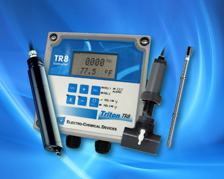Triton TR8 Analyzer With Intelligent Sensor Technology for Suspended Solids Measurement in Wastewater
Ideal for the Activated Sludge Process, Return & Waste Activated Sludge, Paper Manufacturing Filtrate, Blending/Mixing Applications, Environmental Runoff
Engineers in search of a precise, highly reliable, low-maintenance water quality monitoring solution for wastewater treatment and other applications where suspended solids and turbid conditions are present will want to learn more about the Triton TR8 Analyzer from Electro-Chemical Devices (ECD).
Accurate measurement of suspended solids is critical to maintaining the proper level of activated sludge in an aeration basin. Adjustments to the return and removal rates of the activated sludge can improve the efficiency of the basin in reducing the COD and BOD of the mixed liquor. The TR8 is available with immersion fittings for service in the aeration basin or insertion fittings for the return and waste activated sludge lines.
The high range TR8 Analyzer is used to measures suspended solids or turbidity at levels greater than 500 NTU, with output available in multiple units: 0.00-9999 FNU, 0.00-9999 ppm, 0-300g/l and 0-200 percent. The TR8 TA sensor features an error rate of less than 5 percent of reading with repeatability greater than 1% percent of reading.
The Triton TR8’s sensor features a unique multi-beam optical assembly. The first light beam is a reference detector that c ompensates for changes in the LED light source caused by aging or other variables. The second light beam detects the short path length, which is best of high concentration measurement. The third light beam measures the longer path length, which is best for lower concentrations.
The Triton TR8 utilizes a highly intelligent microprocessor-based design. Its sensor electronics constantly adjusts suspended solids and turbidity signal readings versus the reference detector for superior measurement accuracy. A built-in digital filter helps to suppress potentially interfering signals while self-monitoring diagnostics assure high reliability.
The Triton TR8’s sensor assembly relies on a long-life near infrared LED light source (880 nm), and the 90-degree scattered light method in accordance with ISO 7027 / EN 27027. The sensor is factory calibrated in formazine, FNU (Formazine Nephelometric Units), and is plug-and-play ready for applications. Two nonvolatile memory banks are also available onboard to store user-initiated calibration data.
Featuring an inclined face that is oriented into the liquid flow for optimum self-cleaning, the rugged Triton TR8’s sensor assembly greatly reduces plant maintenance requirements to the occasional manual sensor swiping with a soft cloth. An optional automated mechanical wiper also is available for heavy-duty service environments or for difficult-to-reach sensor locations.
The Triton TR8’s sensor was developed for rugged water treatment environments, designed to operate at ambient temperatures from -5 to 50°C (20-120°F). It withstands pressures up to a maximum of 6 bar at 25°C and 1 bar at 50°C.
The TR8’s transmitter digitally communicates with the turbidity sensor and provides a 4-20 mA output and alarm relay. The TR8’s controller features ECD’s multi-bus architecture, with up to 2 outputs and 4 SPDT relays. It includes a configurable display and HART protocol communication is available as well. The turbidity sensor can be located up to 200 m away from the controller.



